A Classic Dish with a Creamy Twist
Scalloped potatoes are a classic comfort food that are enjoyed by many people around the world. This dish is typically made by layering thinly sliced potatoes with a creamy sauce and baking it until it is golden brown and bubbly. Scalloped potatoes can be served as a side dish or as a main course, and they are perfect for family dinners, potlucks, and holiday gatherings.

There are many different variations of scalloped potatoes, and each recipe has its own unique twist. Some recipes call for the addition of cheese, bacon, or ham, while others use a variety of herbs and spices to add flavor. Some recipes even use sweet potatoes or other root vegetables in place of the traditional white potatoes. Regardless of the recipe, scalloped potatoes are always a crowd-pleaser and a great way to enjoy a hearty and satisfying meal.
History of Scalloped Potatoes
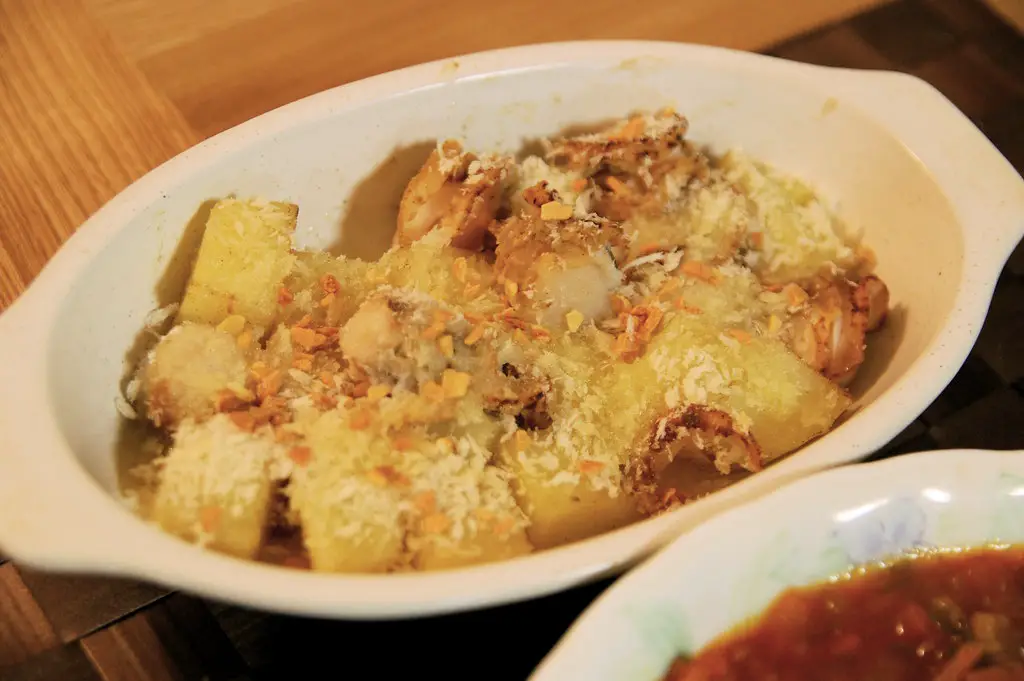
Scalloped potatoes are a classic comfort food that have been enjoyed for generations. This dish has a rich history that dates back to the early days of American cuisine. Here is a brief overview of the history of scalloped potatoes.
Origins and Evolution
The origins of scalloped potatoes are somewhat unclear. Some historians believe that the dish was first created in France, while others believe that it originated in the United States. Regardless of its origins, scalloped potatoes have evolved over time to become a beloved dish that is enjoyed by people all over the world.
The basic recipe for scalloped potatoes consists of thinly sliced potatoes that are layered in a baking dish with butter, cream, and seasonings. The dish is then baked until the potatoes are tender and the top is golden brown. Over time, different variations of the dish have emerged, with some recipes including cheese, breadcrumbs, or other ingredients.
Regional Variations
Scalloped potatoes are a popular dish in many different regions of the world. United States, the dish is often associated with the Midwest and is a staple at potlucks and family gatherings. Canada, scalloped potatoes are often served as a side dish with roast beef or ham.
In some parts of Europe, scalloped potatoes are known as gratin potatoes. These dishes are often made with cheese and breadcrumbs and are a popular side dish for meat and poultry. In Australia and New Zealand, scalloped potatoes are often served as a main dish with vegetables and a salad.
Overall, scalloped potatoes are a versatile and delicious dish that has a rich history and has evolved over time to become a beloved comfort food. Whether you are enjoying them as a side dish or as a main course, scalloped potatoes are sure to satisfy your taste buds and leave you feeling warm and satisfied.
Ingredients for Classic Scalloped Potatoes
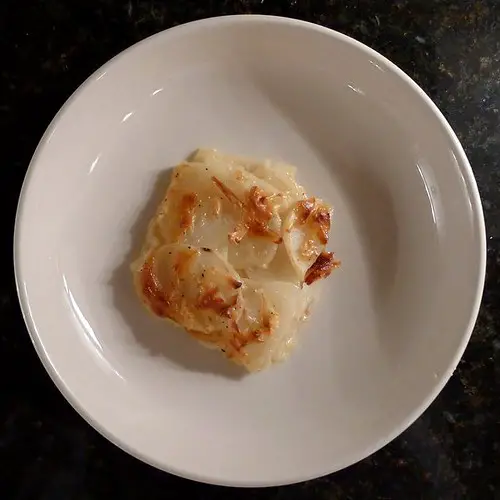
Scalloped potatoes are a classic comfort food dish made with thinly sliced potatoes layered with cream, cheese, and seasonings. Here are the key ingredients you’ll need to make this delicious dish:
Potato Selection
The type of potato you choose will affect the texture and flavor of your scalloped potatoes. Russet potatoes are a popular choice because they are starchy and hold their shape well during cooking. Yukon Gold potatoes are another option, as they have a buttery flavor and creamy texture that pairs well with the cream and cheese in this dish. Whichever type of potato you choose, make sure they are firm and free of any soft spots or blemishes.
Cream and Cheese Options
The cream and cheese are what give scalloped potatoes their rich, creamy flavor. Heavy cream is the traditional choice, but you can also use half-and-half or whole milk for a lighter version. As for cheese, cheddar is a classic choice, but you can also use Gruyere, Parmesan, or a combination of cheeses for a more complex flavor. Be sure to grate your cheese yourself for the best texture and flavor.
Herbs and Spices
To add flavor to your scalloped potatoes, you can use a variety of herbs and spices. Garlic, thyme, and rosemary are all popular choices, as they pair well with the cream and cheese. You can also add a pinch of nutmeg or cayenne pepper for a little extra kick. Salt and pepper are a must, but be sure to taste your dish as you go and adjust the seasonings to your liking.
In summary, to make classic scalloped potatoes, you’ll need potatoes, cream, cheese, and a variety of herbs and spices. Choose firm, blemish-free potatoes and grate your cheese yourself for the best texture and flavor. Experiment with different herbs and spices to find the flavor combination you like best.
Preparation Techniques
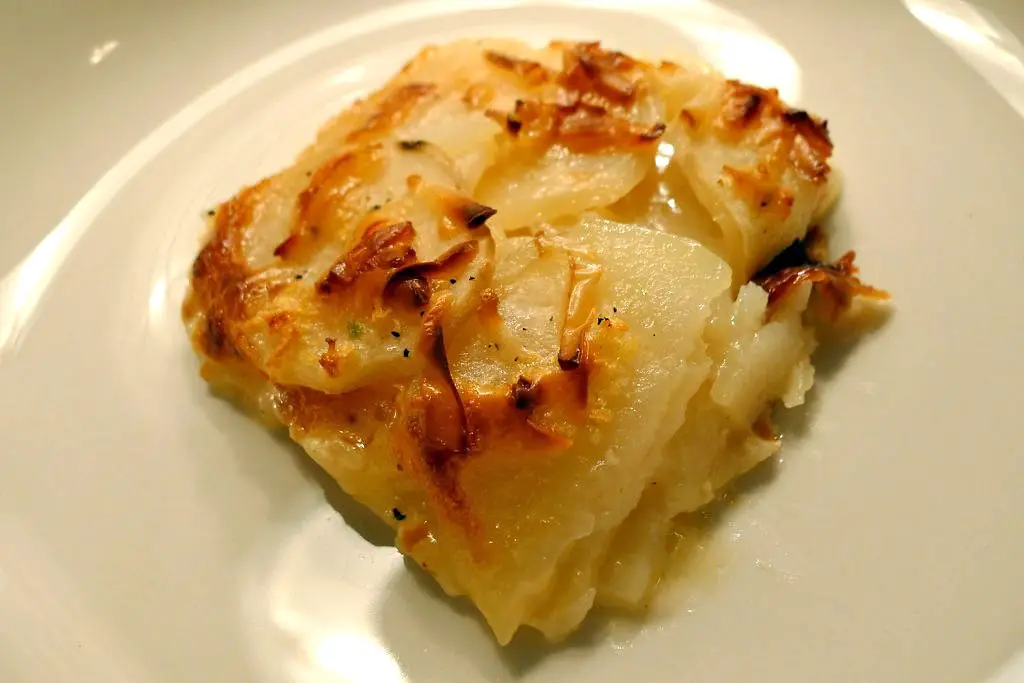
Slicing and Layering
When preparing scalloped potatoes, it is important to slice the potatoes thinly and evenly. This can be done using a sharp knife or a mandoline slicer. The thinner the slices, the faster the potatoes will cook and the more evenly they will cook.
Once the potatoes are sliced, they should be layered in a baking dish with any other ingredients, such as cheese or onions. It is important to layer the potatoes evenly to ensure that they cook evenly. You can also alternate layers of potatoes with layers of other ingredients to add flavor and texture to the dish.
Baking Tips
When it comes to baking scalloped potatoes, there are a few tips to keep in mind. First, cover the dish with aluminum foil to prevent the top from burning before the potatoes are fully cooked. Remove the foil during the last few minutes of baking to allow the top to brown and crisp up.
Second, make sure the potatoes are fully cooked before serving. You can test this by inserting a knife into the center of the dish. If the potatoes are soft and tender, they are done. If there is still resistance, continue baking until they are fully cooked.
Finally, allow the dish to cool for a few minutes before serving. This will help the flavors to meld together and make it easier to serve.
By following these simple preparation techniques, you can create a delicious and satisfying dish of scalloped potatoes.
Cooking Methods
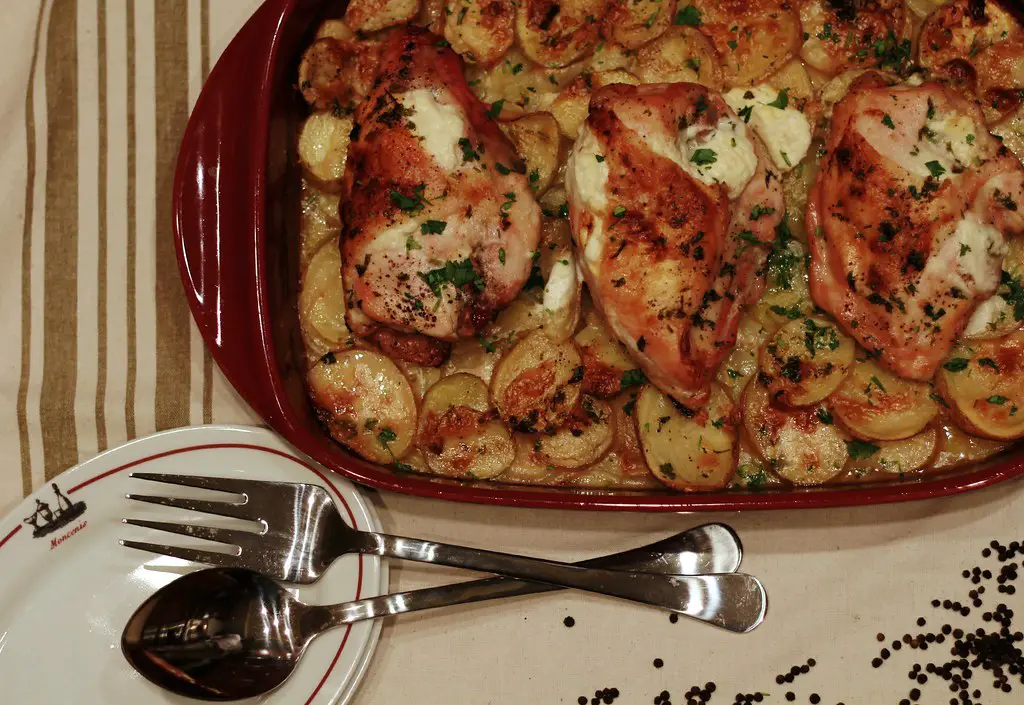
When it comes to cooking scalloped potatoes, there are a few different methods you can use depending on what appliances you have available. In this section, we’ll cover two popular methods: traditional oven baking and alternative cooking appliances.
Traditional Oven Baking
The most common way to make scalloped potatoes is by baking them in the oven. To start, preheat your oven to 375°F. Then, slice your potatoes thinly and layer them in a greased baking dish. Next, mix together a sauce of milk, butter, flour, and cheese, and pour it over the potatoes. Bake in the oven for 45-50 minutes, or until the potatoes are tender and the top is golden brown.
If you want to get creative, you can add other ingredients to your scalloped potatoes, such as bacon, ham, or onions. You can also experiment with different types of cheese to find the perfect flavor combination. Just keep in mind that the cooking time may vary depending on what ingredients you add.
Alternative Cooking Appliances
If you don’t have access to an oven, don’t worry! There are other appliances you can use to make scalloped potatoes. For example, you can make them in a slow cooker or on the stovetop.
To make scalloped potatoes in a slow cooker, simply layer your sliced potatoes in the crockpot and pour your sauce over them. Cook on low for 6-8 hours, or until the potatoes are tender. You can also add other ingredients to your slow cooker, such as diced ham or chopped onions.
To make scalloped potatoes on the stovetop, you’ll need a large pot with a lid. Start by melting butter in the pot, then add your sliced potatoes and sauté for a few minutes. Next, add your sauce and bring it to a simmer. Cover the pot with a lid and let it cook for 20-25 minutes, or until the potatoes are tender.
No matter which cooking method you choose, making scalloped potatoes is a delicious and satisfying way to enjoy this classic dish.
Serving Suggestions

Scalloped potatoes are a classic side dish that can complement many main courses. Here are some serving suggestions to help you make the most of your scalloped potatoes.
Accompaniments
Scalloped potatoes pair well with a variety of proteins, including beef, chicken, ham, and fish. For a hearty meal, serve scalloped potatoes with meatloaf or beef Wellington. The creamy, cheesy potatoes are the perfect complement to the rich, savory flavors of these dishes.
If you prefer chicken, try serving scalloped potatoes with rosemary chicken. The creamy sauce of the chicken pairs well with the cheesy potatoes while the rosemary adds an herbal flavor to both dishes. For a fish option, pan-seared salmon is a great choice. The rich, buttery flavor of the salmon pairs well with the creamy, cheesy potatoes.
Presentation Tips
Scalloped potatoes can be presented in a variety of ways to suit different occasions. For a casual meal, serve the potatoes in a large baking dish or casserole dish. For a more formal meal, consider serving individual portions in ramekins or small baking dishes.
To add some visual interest to your presentation, consider topping the scalloped potatoes with breadcrumbs or grated cheese before baking. This will create a golden, crispy crust on top of the creamy potatoes.
Another way to add some visual interest is to use a mandoline slicer to create uniform, thin slices of potatoes. This will create a more elegant presentation and will also help the potatoes cook more evenly.
In summary, scalloped potatoes are a versatile side dish that can be paired with a variety of proteins and presented in a variety of ways. Use these serving suggestions to make your next scalloped potato dish a success.
Nutritional Information
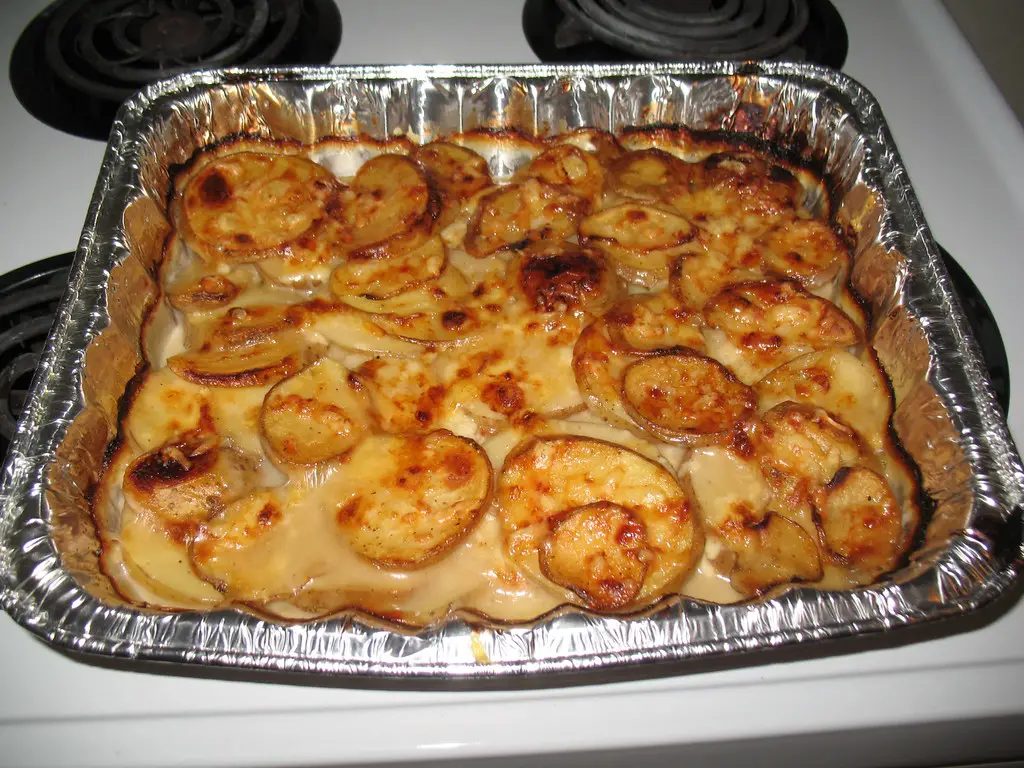
Caloric Content
Scalloped potatoes are a delicious and creamy side dish that is enjoyed by many. However, they are not the healthiest option due to their high caloric content. One cup of scalloped potatoes contains approximately 217 calories [1]. If you are trying to watch your calorie intake, it is important to be mindful of your portion sizes when consuming scalloped potatoes.
Dietary Considerations
Scalloped potatoes are high in carbohydrates and contain a moderate amount of protein. One cup of scalloped potatoes contains approximately 31 grams of carbohydrates and 5 grams of protein [1]. If you are following a low-carb or high-protein diet, scalloped potatoes may not be the best choice for you.
Scalloped potatoes are also high in fat, with one cup containing approximately 9 grams of fat [2]. If you are watching your fat intake, it is important to be mindful of your portion sizes when consuming scalloped potatoes.
If you have dietary restrictions or allergies, it is important to be aware of the ingredients used in scalloped potatoes. Many recipes contain dairy products, such as milk and cheese, which may not be suitable for those who are lactose intolerant or have a milk allergy.
In summary, scalloped potatoes are a delicious and indulgent side dish that should be consumed in moderation due to their high caloric content and fat content. If you have dietary restrictions or allergies, it is important to be aware of the ingredients used in scalloped potato recipes.
Sources
Recipe Variations
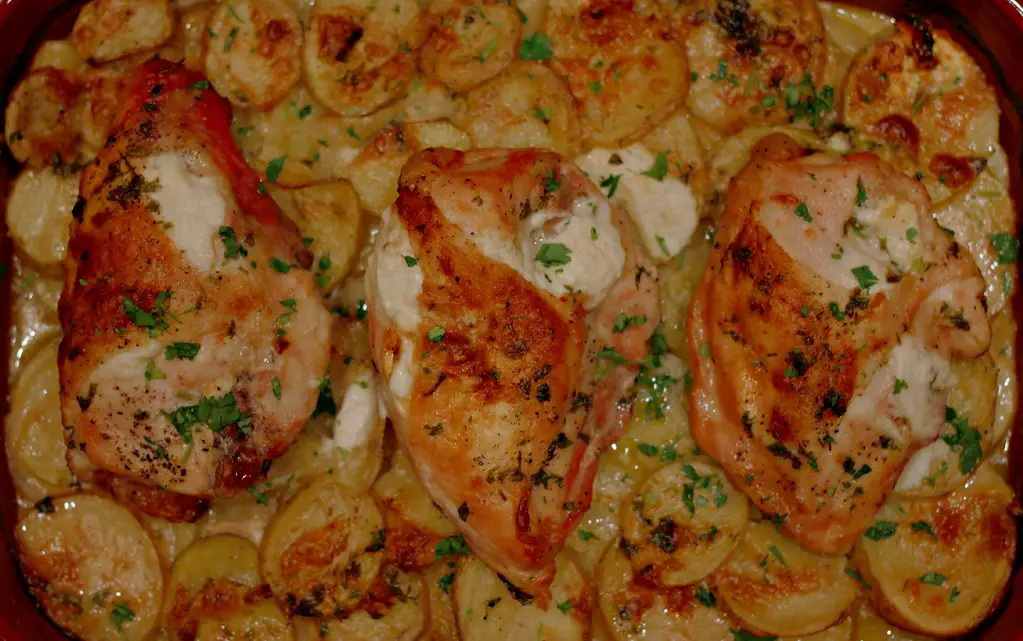
If you’re looking to switch up your scalloped potato recipe, there are plenty of variations to try. Here are a few ideas to get you started:
Vegetarian and Vegan Versions
For a vegetarian or vegan version of scalloped potatoes, simply omit the dairy products and replace them with plant-based alternatives. Instead of butter, use a vegan butter or margarine, and instead of milk or cream, use a non-dairy milk such as almond or soy milk. You can also add nutritional yeast for a cheesy flavor.
Low-Carb and Keto Adaptations
If you’re following a low-carb or keto diet, you can still enjoy scalloped potatoes with a few adaptations. Instead of using potatoes, use a low-carb vegetable such as cauliflower or turnips. You can also use a low-carb thickener such as xanthan gum or arrowroot powder instead of flour. Finally, use a high-fat dairy product such as heavy cream or cream cheese instead of milk or half-and-half.
No matter which variation you choose, make sure to adjust cooking times and temperatures as needed. With a little experimentation, you can create a scalloped potato recipe that is perfect for your taste preferences and dietary needs.
Storage and Reheating

When it comes to scalloped potatoes, proper storage and reheating techniques are crucial to maintain their quality and taste. In this section, we’ll cover the best practices for storing and reheating scalloped potatoes.
Refrigeration Best Practices
To ensure that your scalloped potatoes stay fresh and safe to eat, it’s important to store them properly in the refrigerator. Here are some tips to keep in mind:
- Allow the potatoes to cool down to room temperature before refrigerating them. This will prevent moisture from building up in the container and causing the potatoes to become soggy.
- Store the potatoes in an airtight container or wrap them tightly in plastic wrap or aluminum foil.
- Label the container with the date you made the potatoes, so you know how long they’ve been in the fridge.
- Store the potatoes in the back of the fridge, where the temperature is the most consistent.
Scalloped potatoes can be stored in the refrigerator for up to 4 days. After that, they may start to lose their texture and flavor.
Reheating for Best Quality
When reheating scalloped potatoes, the goal is to get them hot all the way through without overcooking them or drying them out. Here are some methods to consider:
- Oven: Preheat your oven to 350°F and place the potatoes in an oven-safe dish. Cover the dish with foil to prevent the top layer from becoming too crispy. Heat the potatoes in the oven for about 20-30 minutes, or until they are heated through.
- Stovetop: Place the potatoes in a saucepan with a little bit of milk or cream. Heat the potatoes on low heat, stirring occasionally, until they are hot all the way through.
- Microwave: Place the potatoes in a microwave-safe dish and cover the dish with a damp paper towel. Heat the potatoes on high for 1-2 minutes, or until they are heated through.
No matter which method you choose, be sure to stir the potatoes occasionally to ensure that they heat evenly. If the potatoes start to dry out, you can add a little bit of milk or cream to them to help moisten them up.
By following these storage and reheating techniques, you can enjoy delicious and flavorful scalloped potatoes even after they’ve been cooked and refrigerated.
Common Mistakes and Troubleshooting

Avoiding Soggy Potatoes
Soggy potatoes are a common problem when making scalloped potatoes. To avoid this, make sure to slice your potatoes thinly and evenly. Thick slices will take longer to cook, and may not cook evenly, which can result in some slices being overcooked and others being undercooked. Uneven slices can also lead to some potatoes absorbing more liquid than others, which can result in a soggy dish.
Another way to avoid soggy potatoes is to remove excess moisture from them before baking. You can do this by patting them dry with a paper towel or kitchen towel. Alternatively, you can let them sit in a colander for a few minutes to allow any excess moisture to drain off.
Ensuring Even Cooking
One common mistake when making scalloped potatoes is not ensuring even cooking. This can result in some potatoes being overcooked and others being undercooked. To ensure even cooking, make sure to slice your potatoes thinly and evenly. This will help them cook at the same rate.
Another way to ensure even cooking is to layer your potatoes evenly in the baking dish. Make sure to spread them out in a single layer, and avoid piling them on top of each other. This will help the heat distribute evenly, and ensure that all the potatoes cook at the same rate.
Finally, make sure to cover your dish with foil during the first part of the baking process. This will help the potatoes cook evenly, and prevent them from drying out. Once the dish is nearly done, you can remove the foil to allow the top to brown and crisp up.
By following these tips, you can avoid common mistakes when making scalloped potatoes, and ensure that your dish turns out perfectly every time.
Food Safety and Hygiene

Handling Raw Ingredients
When making scalloped potatoes, it is important to handle the raw ingredients properly to prevent foodborne illnesses. Potatoes should be washed thoroughly under running water before peeling and slicing. You should use a clean cutting board and knife to prevent cross-contamination. Also, make sure to wash your hands with soap and warm water before and after handling raw potatoes.
Preventing Cross-Contamination
Cross-contamination can occur when bacteria from one food item is transferred to another. To prevent cross-contamination, you should always use separate cutting boards and utensils for raw meat, poultry, seafood, and vegetables. When making scalloped potatoes, it is important to keep the raw potatoes separate from other ingredients to prevent cross-contamination.
To further prevent cross-contamination, you should clean and sanitize all surfaces and utensils that come into contact with raw potatoes. This includes cutting boards, knives, bowls, and countertops. You can use a solution of one tablespoon of unscented, liquid chlorine bleach per gallon of water to sanitize surfaces.
When storing leftover scalloped potatoes, make sure to use airtight containers and store them in the refrigerator within two hours of cooking. Leftovers should be consumed within three to four days. If you are reheating leftover scalloped potatoes, make sure they reach an internal temperature of 165°F to kill any bacteria that may have grown.
By following these food safety and hygiene practices, you can enjoy delicious and safe scalloped potatoes.
Frequently Asked Questions

How can I make scalloped potatoes more flavorful?
To make your recipe more flavorful, consider adding herbs such as thyme, rosemary, or parsley. You can also add garlic or onion powder, or even diced onions or garlic. Some recipes call for adding a small amount of Dijon mustard or Worcestershire sauce to enhance the flavor. Experiment with different seasonings to find your perfect combination.
What is the best cheese to use for cheesy scalloped potatoes?
The best cheese for this recipe is a matter of personal preference. Cheddar cheese is a popular choice, but you can also use Gruyere, Swiss, or Parmesan. Some recipes call for a combination of cheeses. Consider the flavor and texture of the cheese when selecting which one to use.
Can scalloped potatoes be made gluten-free without compromising on taste?
Yes, this recipe can be made gluten-free without compromising on taste. Substitute all-purpose flour with gluten-free flour or cornstarch. Use gluten-free breadcrumbs or crushed gluten-free crackers for the topping. Check the labels of all ingredients to ensure they are gluten-free.
What are some tips for making quick and easy scalloped potatoes?
To make quick and easy recipe, use a mandoline slicer to slice the potatoes thinly and evenly. Parboil the potatoes for a few minutes to speed up the cooking process. Use a pre-made cream sauce or condensed cream of mushroom soup. Layer the potatoes and sauce in a baking dish and bake until the potatoes are tender and the top is golden brown.
How do you incorporate ham into a scalloped potatoes recipe?
To incorporate ham into this recipe, dice the ham into small pieces and layer it between the potato slices. You can also mix the ham into the cream sauce before layering it with the potatoes. Another option is to place a layer of ham on top of the potatoes before adding the cheese topping.
What’s the key to achieving the perfect texture for scalloped potatoes?
The key to achieving the perfect texture for this recipe is to slice the potatoes thinly and evenly. Use a mandoline slicer to ensure uniform slices. Don’t overcook the potatoes, as they will become mushy. Bake the potatoes until they are tender but still hold their shape. Allow the dish to rest for a few minutes before serving to allow the sauce to thicken.
External Links

If you want to learn more about this recipe, here are some external links that you may find useful:
- Classic Scalloped Potatoes Recipe from King Arthur Baking: This recipe provides a classic take on scalloped potatoes. It includes detailed instructions on how to prepare and slice the potatoes, as well as how to make the creamy sauce that gives this recipe their signature flavor.
- Scalloped Potatoes Recipe from Allrecipes: This recipe is a great option if you are looking for a simple, straightforward approach to making scalloped potatoes. It includes step-by-step instructions and photos to help you along the way.
- Scalloped Potatoes Recipe from Betty Crocker: This recipe is another classic take on this recipe. It includes a few variations, such as adding cheese or ham, to help you customize the dish to your liking.
- Scalloped Potatoes Recipe from Spend With Pennies: This recipe is a great option if you are looking for a rich and creamy version of scalloped potatoes. It includes a homemade cream sauce that is sure to impress your guests.
- The Easiest Scalloped Potatoes from Feasting at Home: This recipe is a great option if you are short on time but still want to enjoy the deliciousness of scalloped potatoes. It includes a few shortcuts, such as using a mandoline or food processor to slice the potatoes, that can help you save time in the kitchen.
Whether you are a seasoned pro or a beginner in the kitchen, these external links can help you create delicious and satisfying recipe.
More FAQs
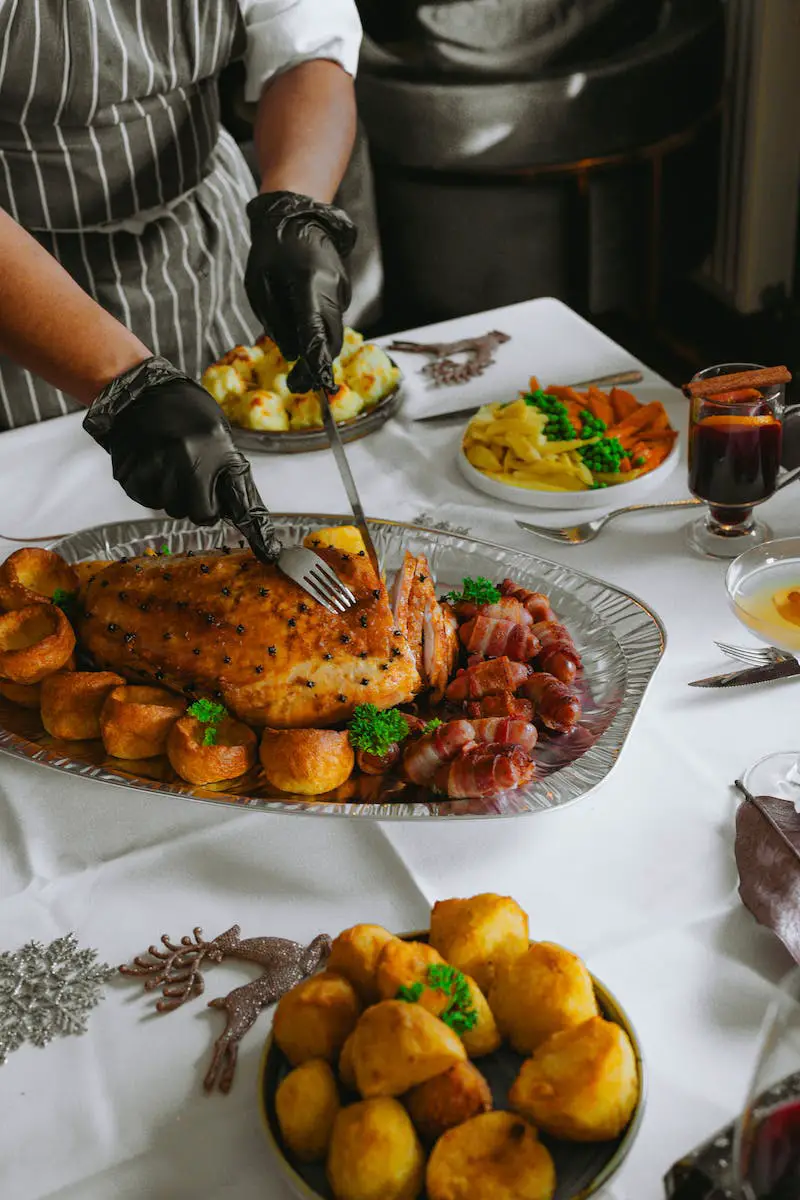
Are you still wondering about this recipe? Here are some more frequently asked questions that might help you out.
What food goes well with scalloped potatoes?
this recipe is a versatile dish that can be paired with many different foods. They are a classic side dish that goes well with roasted or grilled meats, such as pork, beef, or chicken. You can also serve them with a green salad or roasted vegetables for a complete meal. For a more casual meal, try serving scalloped potatoes with hot dogs or hamburgers.
Why do they call them scalloped potatoes?
The term “scalloped” refers to the shape of the dish that the potatoes are traditionally baked in. The dish has a scalloped edge, which gives the potatoes their name. this recipe is also sometimes called au gratin potatoes, which refers to the crispy, browned cheese that is often sprinkled on top.
Why are my scalloped potatoes bland?
If your recipe is bland, it may be because you didn’t add enough seasoning. Potatoes can be quite bland on their own, so it’s important to add enough salt and pepper to bring out their flavor. You can also try adding other seasonings, such as garlic, thyme, or rosemary, to give your scalloped potatoes more flavor.
Why are my scalloped potatoes watery?
If this recipe is watery, it may be because you didn’t cook them long enough. Potatoes release a lot of moisture as they cook, so it’s important to bake them until they are tender and the liquid has thickened. You can also try using less liquid in your recipe or adding a thickener, such as flour or cornstarch, to help absorb the excess liquid.
Conclusion

Congratulations! You now know how to make delicious recipe. Remember to use the right type of potato, slice them thinly, and use enough fat and liquid in the sauce.
To prevent overcooking, use moderate oven temperatures for a gentle cook. If you encounter any issues, such as the potatoes turning out too firm or hard, refer to the troubleshooting tips mentioned in the search results.
When it comes to seasoning, feel free to experiment with different herbs and spices to suit your taste. Some popular options include garlic, thyme, rosemary, and nutmeg.
If you’re looking to make a more indulgent version of this recipe, consider using cream instead of milk and adding cheese to the sauce. However, keep in mind that this will increase the dish’s calorie and fat content.
Overall, this recipe is a versatile and delicious side dish that can be enjoyed on their own or paired with a variety of main courses. Whether you’re cooking for a family dinner or a special occasion, scalloped potatoes are sure to be a crowd-pleaser.
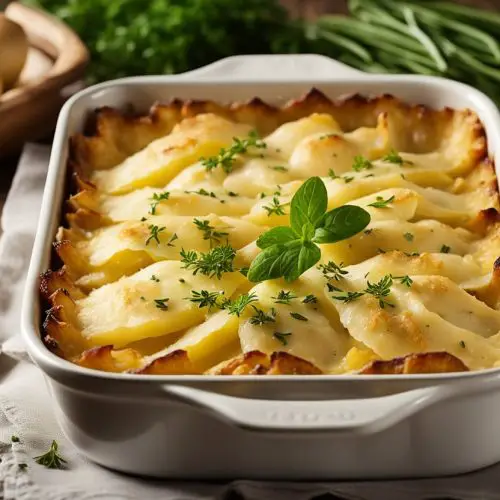
Scalloped Potatoes
Ingredients
- 2 pounds russet potatoes, peeled and thinly sliced
- 1/4 cup unsalted butter
- 1/4 cup all-purpose flour
- 1/2 teaspoon salt
- 1/4 teaspoon black pepper
- 2 cups whole milk
- 1 cup shredded cheddar cheese
- 1/2 cup grated Parmesan cheese
- 2 cloves garlic, minced
- 1 teaspoon dried thyme
Instructions
- Preheat the oven to 350°F (175°C).
- In a medium saucepan, melt the butter over medium heat. Stir in the flour, salt, and pepper until well combined.
- Gradually whisk in the milk, ensuring no lumps form. Continue to cook and stir until the mixture thickens.
- Add the minced garlic, cheddar cheese, and Parmesan cheese. Stir until the cheeses are melted and the sauce is smooth. Remove from heat.
- Arrange a layer of sliced potatoes in a greased baking dish. Pour a portion of the cheese sauce over the potatoes.
- Repeat layering potatoes and cheese sauce until all ingredients are used, finishing with a layer of sauce on top.
- Sprinkle dried thyme over the top layer for added flavor.
- Cover the baking dish with aluminum foil and bake in the preheated oven for 45 minutes.
- Remove the foil and bake for an additional 15-20 minutes or until the top is golden brown, and the potatoes are tender.
- Allow the scalloped potatoes to rest for 10 minutes before serving.

